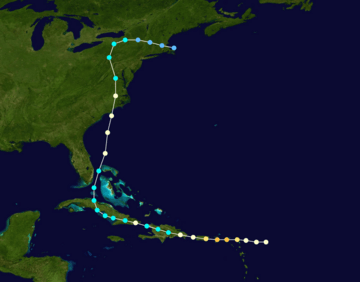1876 San Felipe hurricane facts for kids
| Category 3 major hurricane (SSHWS/NWS) | |

Hurricane Track
|
|
| Formed | September 12, 1876 |
|---|---|
| Dissipated | September 19, 1876 |
| Highest winds | 1-minute sustained: 120 mph (195 km/h) |
| Lowest pressure | 980 mbar (hPa); 28.94 inHg |
| Fatalities | 21 |
| Areas affected | Antigua, St. Kitts, Virgin Islands, Puerto Rico, Hispaniola, the Carolinas |
| Part of the 1876 Atlantic hurricane season | |
The San Felipe Hurricane was a powerful storm that happened in 1876. It was the second big storm of the 1876 Atlantic hurricane season. This hurricane is remembered for its path and the damage it caused.
The storm started near the Leeward Islands on September 12th. It grew stronger, becoming a powerful Category 3 hurricane as it moved towards Puerto Rico. The hurricane then hit Hispaniola and Cuba, still very strong. It got a bit weaker as it crossed Cuba, then passed by Florida. But it got strong again and hit Wilmington, North Carolina. It slowly lost power as it moved over the United States, finally disappearing near Cape Cod on September 19th. This hurricane was the only storm that year to cause deaths.
Contents
How the Hurricane Formed and Moved
A hurricane was first seen east of the Leeward Islands on September 12th. It hit these islands that very night. The storm first passed through Antigua, St. Kitts, and the Virgin Islands.
Storm Reaches Puerto Rico
The next day, September 13th, the storm became a very strong Category 3 hurricane. It hit Puerto Rico with this strength. The hurricane entered Puerto Rico near Yabucoa and Humacao around seven in the morning. It then left the island through Mayagüez at 1:30 in the afternoon.
In San Juan, the air pressure dropped to about 29.20 inches of mercury (980 hPa). This happened on the morning of September 14th. Winds reached about 60 miles per hour, and it rained about 4.71 inches (120 mm). The hurricane stayed strong as it made landfall on the eastern side of Puerto Rico.
Weakening and Landfall in Hispaniola
Soon after hitting Puerto Rico, the hurricane quickly became weaker. It dropped to a Category 2 hurricane, then to a Category 1 hurricane. This happened after it moved back over the Atlantic Ocean. The storm kept its strength and then hit the eastern tip of the Dominican Republic. At this point, its winds were about 80 miles per hour.
Impact and Memories of the Storm
The San Felipe Hurricane is a famous part of hurricane history in the Antilles. A well-known scientist named Father Benito Viñes traveled from Cuba to Puerto Rico. He went there to study and figure out how much damage the hurricane caused. This was the first hurricane where a rain gauge was used to measure rainfall.
Damage and Deaths
The San Felipe Hurricane affected Puerto Rico for ten hours. It caused the deaths of nineteen people there. However, some historians think that the Spanish government at the time might have hidden the true number of deaths and how much damage was really done in Puerto Rico.
At least two people drowned in Onslow County, North Carolina. In Wilmington, there were reports of floods, damaged buildings, and trees that had been pulled out of the ground. A bridge over Market Street in Wilmington was also washed away by the storm.
Why It's Called San Felipe
The storm was named the "San Felipe Hurricane" because it hit on September 13th. This day is a special holiday, the feast day of Saint Philip. Interestingly, exactly 52 years later, Puerto Rico was hit by another big storm. That storm was called Hurricane San Felipe Segundo.

